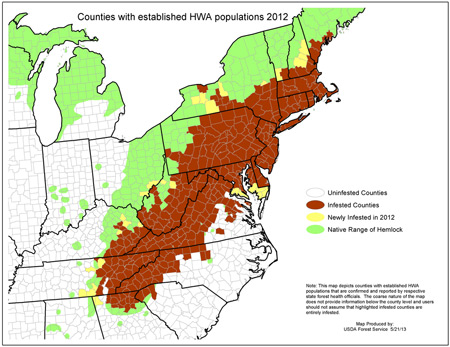By Faith Campbell, Emeritus environmental advocate and tree-pest expert
Nearly 500 non-native insects and disease-causing pathogens have been introduced to the United States in the 400 years since European settlement began. Here are some examples:
- Chestnut blight has virtually eliminated mature American chestnuts across the species’ range, which is most of the eastern deciduous forest.
- European gypsy moth periodically causes severe defoliation of several hardwood species, especially oaks. The gypsy moth now occupies forests from New England to a line reaching from Virginia to Wisconsin.
- Hemlock woolly adelgid has killed 90 percent of hemlocks in groves spanning from Maine to Georgia. These hemlock groves form unique ecosystems that shelter specific bird, fish, salamander, and plant species.
- Emerald ash borer (EAB) has spread over 25 years to more than 100,000 square miles across 23 states and two Canadian provinces. EAB is likely to kill most trees belonging to two dozen species of ash in the U.S., Canada and Mexico.
- White pine blister rust has reduced populations of several western white pines. The greatest threat is to high-elevation pines — whitebark, limber and bristlecone — which are the base of food webs and protect snow cover that is the foundation for water supplies in the West.
- Sudden oak death has killed more than 1 million tanoak and oak trees in the coastal mountains of California and southern Oregon. Many tree and shrub species vulnerable to this disease grow in eastern forests, so scientists worry that the pathogen might become established there.
The U.S. Forest Service offers a database of tree pests and diseases that have been documented across the country. [Simply select your state and/or county from the drop-down menus to see which pests are damaging trees in your region or city.]
Northeastern states have traded with Europe and Asia for about 400 years, which explains why the region has the most established non-native tree-killing pests: 62 in New York; 58 in Pennsylvania; 57 in Connecticut; 55 in New Jersey. Pacific coast states have been trading for only about 150 years, but they are catching up: There are now 42 pests in California; 41 in Washington and 36 in Oregon. In California alone, non-native forest pests now make up one-third of the damaging pests in the state — up from only 10 percent just 50 years ago.
How did these insects and disease-causing pathogens invade the U.S.? Most arrived on imports of plants or in the crates, pallets, and other types of packaging made from wood. In my follow-up posts, I’ll go into more detail about these pest-ridden pathways and what governments, importers and private citizens can do to help prevent additional introductions and spread of established pests to other vulnerable areas.

